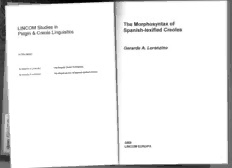
The Morphosyntax of Spanish-lexified creoles PDF
42 Pages·2001·12.797 MB·English
Most books are stored in the elastic cloud where traffic is expensive. For this reason, we have a limit on daily download.
Preview The Morphosyntax of Spanish-lexified creoles
Description:
Earlier studies have compared the verb phrase and the noun phrase of Palenquero (Colombia) and Papiamentu (Netherlands Antilles), resulting in a better understanding of the interrelationship of these Caribbean creoles. This assessment of their structural similarities and differences has again raised the issue of their origins. Palenquero and Papiamentu have certain features which are difficult to explain without referring to their African component. It is even more difficult to account for their diverging in their non-European linguistic features, e.g. pluralization. This monograph presents the first morphosyntactic comparison of all the Spanish-lexified creoles., including Chabacano (Philippines). Aside from the shared features from Spanish, Chabacano can be expected to have distinct features due to its distinct Austronesian substrate, e.g. the Tagalog and Visayan languges. If we can assume that Chabacano underwent creolization in a way parallel to Palenquero and Papiamentu, certain features in the Philippine creole must be seen in the light of Austronesian linguistics. However, this interpretation does not rule out other influences in the creole's genesis and development, e.g. that of the superstrate and universal tendencies. After a short chapter on the social history of the three Spanish-lexified creoles, this work provides a comparative account of the noun phrase and verb phrase of Chabacano, Palenquero and Papiamentu, including discussions of various classes of determiners, the copula and the tense-aspect-modality system.
See more
The list of books you might like
Most books are stored in the elastic cloud where traffic is expensive. For this reason, we have a limit on daily download.
